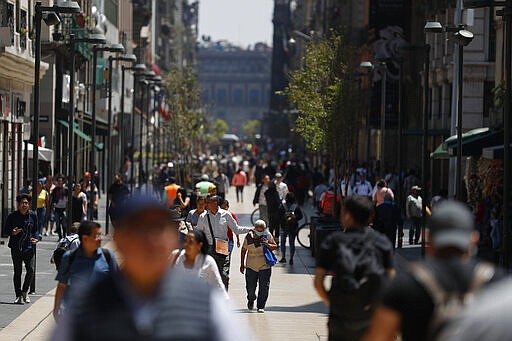Mexico's busy streetscape slows, but doesn't stop for virus
MEXICO CITY (AP) — Increasingly empty beaches and quieter streets in Mexico contrast with a still-crowded subway system and active street vendors, as shut-downs and social distancing measures have begun but remain very uneven.
Shutting down Mexico, where many people live day-to-day off what they earn in the streets, is going to be harder than in Europe or the United States, and its government is reluctant to implement some of the extreme measures and lockdowns seen in those countries.
“We are going to continue living life as normal, and at some point the president is going to tell you when to stay at home,” President Andrés Manuel López Obrador told a crowd in Oaxaca over the weekend. “But right now, we can still get together, keeping a healthy distance.”
“Don't stop going out, I will tell you when you have to stay home," López Obrador told Mexicans, urging them to continue frequenting restaurants, citing fears of the economic impact of restrictive measures in a country where a day without work means a day without food for many. “Millions of Mexicans live day to day."
On Monday, the notoriously bad traffic in Mexico City — where 21 million live in the greater metropolitan area — was unusually light. Banks, restaurants and stores were nearly empty, and employees seemed to spend as much time cleaning windows and tables as waiting on customers.
But public markets, street vendors and food stands continued to bustle, and in the capital's subway system — which transports about 5.5 million riders per day — passengers were packed like sardines at some stations. Some countries south of Mexico have already cut off transportation or declared curfews or lockdowns.
Mexico has 316 confirmed cases of Coronavrius and two deaths, and despite the reluctance of the federal government to limit activities, officials in some cities and states are taking measures to thin out crowds.
For example, Mexico City — which is governed by López Obrador's Morena party — has ordered the closure of gyms, bars, theaters, movie houses, zoos and sports stadiums, and prohibited gatherings of more than 50 people.
Assistant Health Secretary Hugo López-Gatell has supported such measures, but he came down hard on some state and local governments that have gone further, declaring curfews.
“That is contrary to the law, it is not appropriate, it hinders response times and it shouldn't happen,” López-Gatell said.
Some people who were still conducting business on the streets of Mexico City said they were doing it out of necessity: about 56% of workers in Mexico City labor in the 'informal sector," as self-employed vendors or craftspeople.
Enrique Vázquez, 74, has been shining shoes for 27 years on one of the capital's main boulevards. He usually makes about $8 per day, but on Monday, because of the light foot traffic, he made only about $2.
“It's going to be tough,” Vázquez said.
But there is also an element of bravado in the face of the pandemic.
“It doesn't scare me, because I am healthy, thank God,” he said.
But desperation has already broken out in other places in Mexico that are more dependent on foreign tourists, who have largely vanished.
Hotel occupancy was falling in the Caribbean resort of Cancun, and in the Baja California resort of Cabo San Lucas, restaurants began to close down.
“What is happening in Los Cabos is a serious blow that is unprecedented in the tourism industry,” the Los Cabos business coordinating council said in a statement.
Mexico also suffers from being so close to — and so economically dependent on — the United States, where coronavirus cases have risen into the tens of thousands and shutdowns have spread.
Indeed, López Obrador thanked the United States for not totally closing the two countries' borders, even while the governor of one state, Jalisco, publicly called Monday for cancelling incoming flights from the United States.
“Mexico is like a piñata, it's getting hit from all sides," said Moody’s Analytics analyst Alfredo Coutiño, referring to the drop in tourism, oil prices and the value of the peso.














